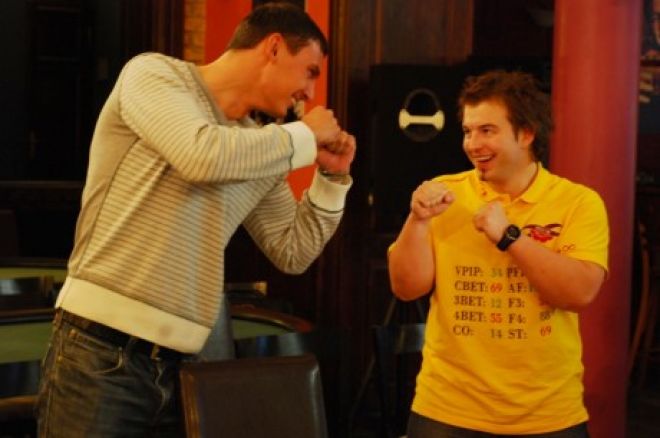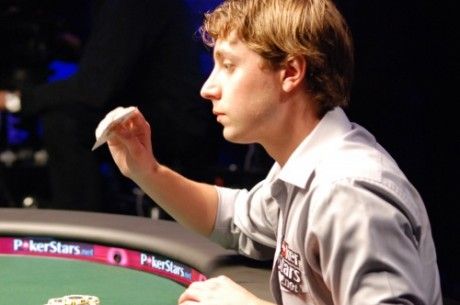Thinking Poker: Fighting Back, Part 1 (Aggression)

Nate Meyvis returns with the first of two articles offering advice to new players looking for ways to counter moves made by more experienced players who are targeting them.
If you are a relative beginner at poker, that means your opponents are likely to view you as a target. That doesn’t just mean that they’ll hope to win money from you — there are specific predatory strategies they’ll employ as they single you out.
Of course, these strategies can all be done well or badly. Sometimes your opponents will make big mistakes as they try to take advantage of your inexperience. But other times they’ll put you in legitimately difficult spots. Judging by the mail Andrew and I get for our podcast, beginners often get confused and cause trouble for themselves when they try to deal with these techniques.
In this article I’ll begin by discussing how to respond to aggression; in a second article, I’ll review other predatory behaviors, and good responses to them. For each one, I’m going to recommend a basic counter-strategy that ought to help keep you out of trouble. I’ll also suggest some more advanced ways of counter-exploiting these players most effectively as you improve and gain experience.
Aggression
What it is: This strategy is what it sounds like. There is a subset of players who love to three-bet beginners before the flop, bet and raise the flop frequently, and keep the pressure on for the later streets also.
Why it works: Aggressive poker is winning poker. Over-aggressive poker can be even better than properly aggressive poker if your opponent doesn’t choose the right times to give up, call down, and fight back. Since we learn about these situations largely through experience, beginners are prone to mishandling them (though more experienced players also make lots of mistakes in response to hyper-aggression).
A first response: Tighten up just a little bit before your opponent gets aggressive. Justin Sadauskas has written about how this is a good response to aggression for anyone. It’s a particularly good counter-tactic for beginners, because going to battle with a much stronger range than your opponent gives you margin for error as the hand plays out.
That doesn’t mean you can pay off big bets with your whole range, nor that you won’t face difficult decisions about whether to value bet or value raise your good-but-not-best hands. But if you go the wrong way on some of these close decisions, having strengthened your ranges by folding more on early streets will help you hold your own.
The best response: If your opponent is playing more aggressively than theory recommends, that means that you ought to win more than your share if you begin with standard, sound ranges and then make good decisions later. Against your most aggressive opponents, these “good decisions” will require that you figure out which hands they’re adding to their betting and raising ranges.
Ultimately, you don’t want to be satisfied just by trying to get full value with your best hands and calling down with other good hands. The tricky part is that against overaggressive opponents you’ll find yourself in subtle, unfamiliar situations. There won’t be an obvious or easy way to analyze them, so the best decisions won’t always be easy to find.
When your opponent figures to be bluffing more often than he ought, and when you can plausibly represent lots of strong hands, you need to turn your weakest hands into bluffs. A simple example of this is when you have called before the flop out of position against an opponent who tends to choose medium connecting cards with which to get out of line. If the board comes with high cards and you happen only to have no pair or an underpair, you will often have a good bluffing opportunity (on the assumption that your out-of-position calling range frequently hits high-card boards well).
If your opponent is not only bluffing on late streets but also value betting thinly, you will have opportunities to get extra value by raising those value bets with hands that would usually be a little too weak for that. For example, against an opponent who has raised before the flop and continues by betting two-thirds of the pot on every street, you will sometimes be able to make a value raise on the river with only AxQx on a QxJx3x4x7x board.
Note, though, that this can be a risky strategy. Putting too much money in the pot with one pair is often exactly what your opponents are trying to do. It’s only correct if your opponent would value bet a lot of queens and jacks all the way down (which is only true of some hyper-aggressive opponents) and if you didn’t choose to raise an earlier street (which will often be better than continuing to check).
It’s hard to know exactly when to get that extra value and make those extra bluffs without having a very strong theoretical understanding of poker and without having a lot of experience with opponents who like to stay on the attack. As you work toward that understanding, and as you gain that experience, tightening up on the early streets will remain your best counter-tactic.
In Part 2, we’ll discuss how to respond to two other ways experienced players like to target those with less experience — talking and trapping.
Be sure to check out Nate and Andrew Brokos on the Thinking Poker podcast, and for more from Nate visit his blog at natemeyvis.com.
Get all the latest PokerNews updates on your social media outlets. Follow us on Twitter and find us on both Facebook and Google+!








